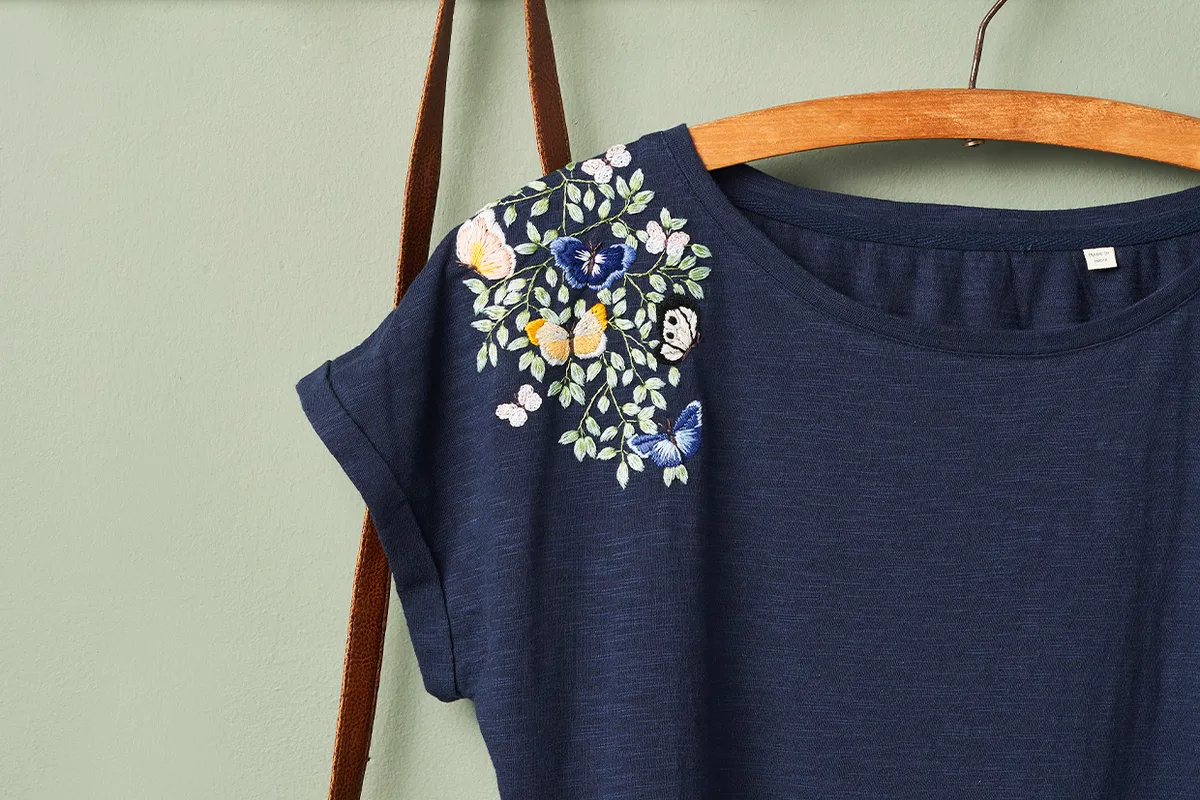Beautiful butterfly embroidery design: Update a tshirt with embroidery
Take a plain old tshirt and make it beautiful with this gorgeous butterfly embroidery designed by Georgie Emery.
If you have never embroidered on clothing before, this t-shirt is a great place to start. Follow along easily with our step-by-step guide (with photos). In our guide below, you'll also find a list of the materials you will need to complete this project, plus a free template for you to transfer onto your chosen t-shirt.
We'll show you everything you need to know about t-shirt embroidery, and in a weekend, you'll have spruced up your first piece of clothing!
If you love (or know someone who loves) butterflies, this will be the perfect project to get stuck into. With delicate leaves and vibrant butterflies created in a wide range of stitches, this project will test your embroidery skills and take them to the next level.
The tshirt embroidery is suitable for advanced beginners, but it does use a variety of stitches. Be sure to check out our helpful guide to embroidery stitches for beginners, if you need to refresh your memory.
The beautiful butterfly embroidery was designed by Georgie Emery and first appeared in Love Embroidery issue 14.
Stitches key for the butterfly embroidery
- Satin stitch - how to do satin stitch
- Backstitch - how to backstitch
- Straight stitch - straight stitch embroidery
- Split stitch - how to do a split stitch
- Brick stitch
- Long and short stitch
- Stem stitch
What to I need to embroider a t-shirt?
- Cotton blend t-shirt: navy blue
- Stranded cotton: 1 skein each of apricot, beige, black, blue, dark blue, light blue, very dark blue, brown, cream, green, light green, grey, orange-yellow, light orange, peach, pink, pale pink, white and yellow
- Embroidery hoop: 18cm diameter Lightweight fusible interfacing (optional)
- Basic embroidery kit
You’ll also need the free tshirt embroidery template.

You will need:
- Cotton tshirt
- Stranded cotton
- Embroidery hoop
- Basic embroidery kit
- Free template
Step 1
Transferring your design
Transfer the design from the template onto the right-hand shoulder of the t-shirt using your preferred method.
We first mounted the t-shirt into a hoop, to support the fabric, and then used a white heat-erasable pen over a lightbox to trace the pattern.
Keep your hoop fairly loose if you are using a stretchy t-shirt, otherwise, your stitching may pucker the fabric.
Step 2
Stitch the leaves
Sew all the leaves in Satin Stitch using two strands of light green. Then, add three or four Straight Stitches over the top of each leaf using one strand of green. Start your stitches at the base of each leaf and work towards the middle each time.

Step 3
Stitch the stems
Work the stems using Stem Stitch in one strand of green.
Step 4
Work the small butterflies using Brick Stitch
The three small butterflies are made using Brick Stitch.
Begin by working a row of Backstitch around the outline of the wing and then fill in row by row, stitching inwards. The bottom wings are stitched using two strands of white and the top wings are stitched using two strands of pink.
Step 5
Stitch the blue butterfly at the bottom of the design
For the blue butterfly at the bottom of the design, start by stitching the lower wings in Long and Short Stitch using two strands.
Start with very dark blue on the edge of the wings and then change to light blue near the body – angle these stitches towards the body.
Then, in vertical Satin Stitch, fill in the middle sections of the upper wings using two strands of blue. Next, with two strands of light blue, stitch the tips of the wings in Satin Stitch.
Step 6
Stitch the central yellow butterfly
Now, for the central yellow butterfly, begin by stitching the tips of the upper wings using two strands of orange-yellow in Satin Stitch.
Then, with two strands of grey, work Satin Stitch along the edge of the lower wings and in the middle sections of the top ones.
Next, fill in the rest of the wings using two strands of light orange on the upper wings and apricot on the lower ones in rows of Split Stitch. Angle all the stitches towards the body so they radiate out from the centre.
Step 7
Stitch the black butterfly
Next, work the black and cream butterfly along the right-hand edge of the design.
Fill in the outer edges of the wings and the circular shapes in Satin Stitch using two strands of black.
Then, with beige and black and using only one strand, work Backstitch over the veins of the wings.
Step 8
Finish the wings with Satin Stitch
Work Satin Stitch in two strands of cream to fill in each of the segments within the wings.
Step 9
Stitch the blue butterfly at the top of the design
Using two strands of dark blue, work Satin Stitch in the centre sections of the upper and lower wings, leaving a space just in front of the template marks clear of stitching.
Then, fill the outer sections with Satin Stitch using two strands of blue. If you have used a non-erasable marker to draw your template lines then take care to cover the marks with your stitching.
Next, using two strands of pale pink, add some Straight Stitches radiating from the centre of the butterfly out to the middle of both the upper and lower wings, varying the length of each stitch.
Step 10
Stitch the peach butterfly
Moving onto the top-left peach butterfly, start by working Satin Stitch along the outer sections of the wings using two strands of pale pink.
Then, with Satin Stitch, fill in the wings using two strands of peach, leaving the middle shape on the upper wing clear.
Next, use two strands of yellow to work Straight Stitches radiating from the centre of the wing towards the middle, varying the length of your stitches.
Step 11
Stitch the bodies and antennae
Once you have stitched the butterfly wings, add the bodies and antennae in two strands of brown. Fill in the bodies and heads with vertical Satin Stitch, then work a single Straight Stitch for the antennae.
Step 12
Iron your stitching on the reverse
Make sure all your thread ends are firmly secured at the back of your work and then remove the stitching from your hoop.
Iron the reverse of your fabric to get rid of any creases left from your hoop. While doing this, the heat from the iron should also erase any of the remaining pen marks (if you used a heat-erasable pen).
You may wish to cut a piece of lightweight fusible interfacing that is slightly larger than the design area and gently fuse it over the back of the work, following the manufacturer’s instructions. This will not only neaten the inside but will protect the back of the stitches, too.
Let butterflies give your tshirt a new lease of life!
We can’t deny that butterfly embroidery is so gorgeous. Butterflies are the perfect subject for embroidery, as the delicate nature of their wings can be beautifully reflected using embroidery thread. The multitude of butterfly species is ideal for stitching, as the colour variations, shapes and sizes are countless!
Don’t stop at t-shirt embroidery
Did you know you can use embroidery to enhance almost any item of clothing? Try these embroidered jeans, adorned with pretty vintage florals.



